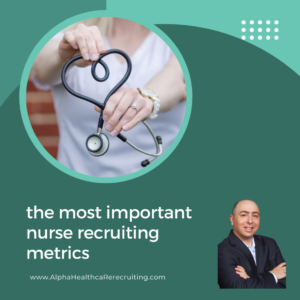Nurse recruiting analytics is a critical way to know how a recruitment is performing overall. There are many different recruitment nurse recruitment metrics that can be measured but choosing the most important metrics can be the difference between tracking useless intel and making better recruitment decisions. This following article will give you insights into what nurse recruitment metrics are effective and what these metrics look like.
Before starting and explaining each metric it is a good idea to first explain what metrics should do. Metrics should do 1 of 3 things in terms of recruiting nurses. It should ever tell you ever how fast you are at getting nurses hired, how accurate you are in your recruitment sourcing strategy and how much it is costing you to recruit nurses.
Recruiting metrics – Time orientated stats
Recruitment metrics measure the effectiveness of recruiters moving quicky through the recruitment Lifecyle. Most ATS/CRM’s can automatically track the time for these stats
- Days to contact applying candidates.
This stat measures how long it takes recruiters to contact applying candidates. This stat should be 1 business day as statically speaking everyday a nurse is not contacted, they become not interested in the role.
- Days to interview applying candidates
This stat measures how long it takes recruiters to interview an applying nurse candidate. This stat should be no more than 3 business days.
- Days to submit interviewed candidate
This stat measures how long it takes recruiters to submit qualified interview candidates to the hiring manager. This stat should be less than 1 business day.
- Days for candidates to receive an offer.
This stat measures how long it takes recruiters to give an offer to a candidate. This stat should be less than 1 business day.
- Time to Fill
This stat measures how long it takes to fill an open nurse role. This is from the time period of opening the req till an offer is accepted by the candidate. This stat is a combination of the effectiveness of both recruitment and the hiring manager moving quickly in the process of getting nurses hired. There must be equal reasonability and SLAs on both ends and you cannot gage the effectiveness of recruitment without looking at hiring managers times as well.
Hiring Manager metrics – Time orientated stats
Hiring Manager metrics measure the effectiveness of hiring managers moving quicky through the recruitment Lifecyle. Most ATS/CRM’s can automatically track the time for these stats
- Days for hiring manager to review
This stat measures how long it takes hiring managers to review submitted candidates. This stat should be less than 1 business day. This stage does not have to take place if recruiters can schedule interviews on a hiring managers calendar.
- Days for hiring manager to interview
This stat measures how long it takes hiring managers to interview a submitted candidate they are interested in. This stat should take be 3-5 business days.
- Days to make offers after interview
This stat measures how long it takes hiring managers to make an offer to an interested candidate. This stat should be less than 1 business day.
Sourcing Stats – Accuracy Stats
Sourcing stats measure how accurate recruitment is with sourcing candidates
- Contact to interest ratio
This stat measures how many contacted candidates it takes to get candidates interested in your roles. For local candidates it should be 25% and for relocating candidates it should be 10%. The effectiveness of this stat is helped by creating compelling job description and contacting the right targeted nurses.
- Submitted to Interview ratio
If you have a submission stage, then you should measure what percentage of submitted candidate that get an interview. As recruiters should know their hiring managers well and therefore should be presenting quality candidate therefore this stat should be at 90%.
- Interview to Offer ratio
This stat measures how many candidates you get interviewed get an offer. This will determine again the quality and accuracy of your screening. For these stat recruiters should be at 50%
- Offer to hire ratio
These stat measures a recruiter’s ability to close candidates. This stat will determine how effective recruiters were in pre-closing candidates throughout the Lifecyle. For these stat recruiters should be at 90%
- Time to Source
This metric calculates how many hours it takes for a recruiter to get a submission. This metric is important as it lets a recruiter know if he or she is working too many hours to get a submission. The average for souring nurses is five hours. For this stat, the recruiter calculates the number of submissions completed in the core sourcing hours worked over a month’s period. For example, if a nurse recruiter worked 160 hours and only 100 of those hours were spent sourcing, then the recruiter would only factor 100 hours into the equation. The core sourcing hours worked (100) would then be divided by the recruiter’s submissions for that month. The final equation would look like: 100 core sourcing hours worked ÷ 25 monthly submissions = 4 hours worked to get a submission.
Cost to hire stat – Cost stat
- ROI of hiring nurses
This stat measures how much it is costing you to source a nurse. This important stat tells you if your current sourcing strategy is cost effective.
This is complicated equation but in a nutshell what you need to do is first calculate how much you are spending per months on various sourcing tools such as Job boards, social media and CRM/ATS fees and then also add in what it is costing you in HR labor to get the candidate hired. For HR labor costs factor in salaries of HR and if they are full-time factor in 25% on top of their salary for benefits.
Then from there take your total recruiting costs divided by the number of nurses you hired. For examples if you spent $500,000 in total recruiting costs per month and divided by 100 RNs you hired that month your ROI of hiring nurses would be $5,000 per RN for that month.
For this stat you can look at individual recruiters or an entire team. Also keep in mind certain geographical regions and certain service lines will be harder to recruit than others. For example, in many areas recruiting in ICU/CIVU will be must most difficult then recruiting for med-surg.
Conclusion
I hope you find this article useful in improving your understanding of nurse recruitment metrics. In addition, if you would like deeper insights my firm Alpha Recruitment offers free Recruitment process improvements consulting. As well as the most cost-effective nurse recruitment strategy.






